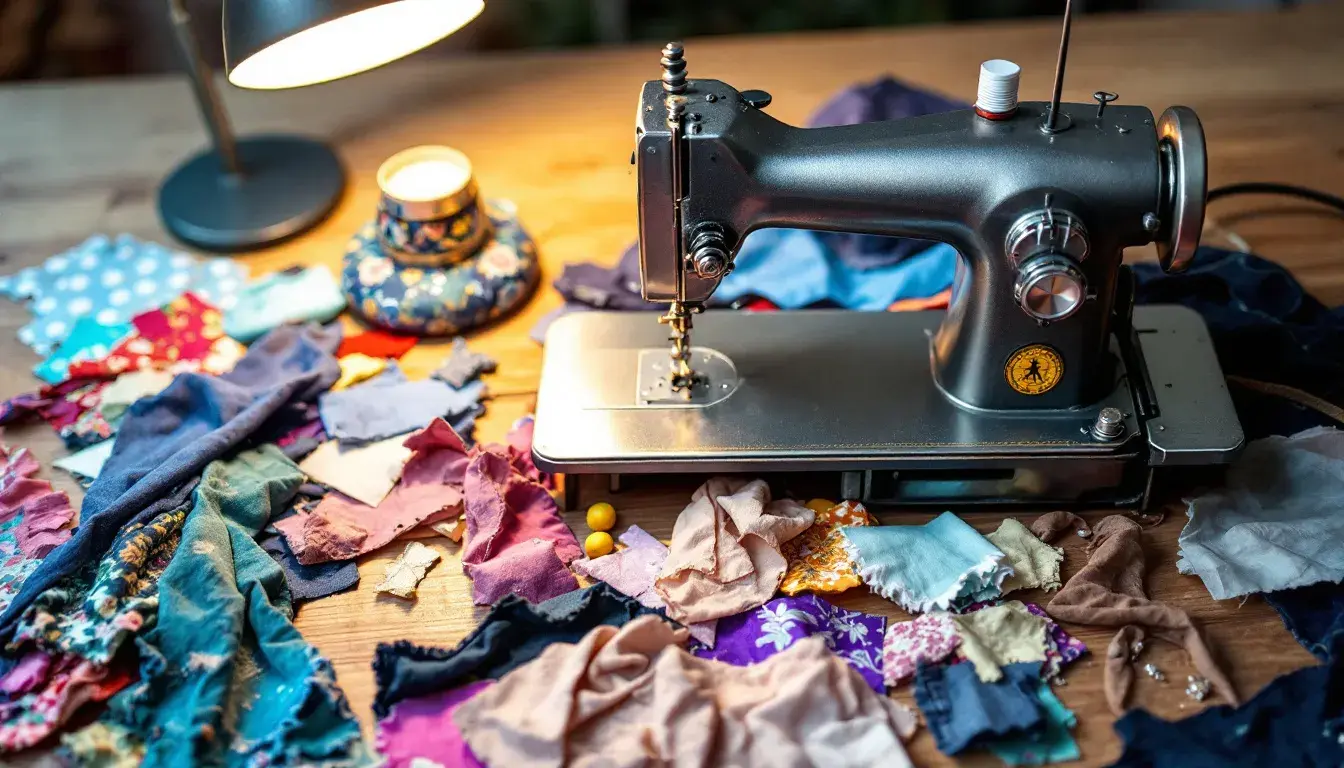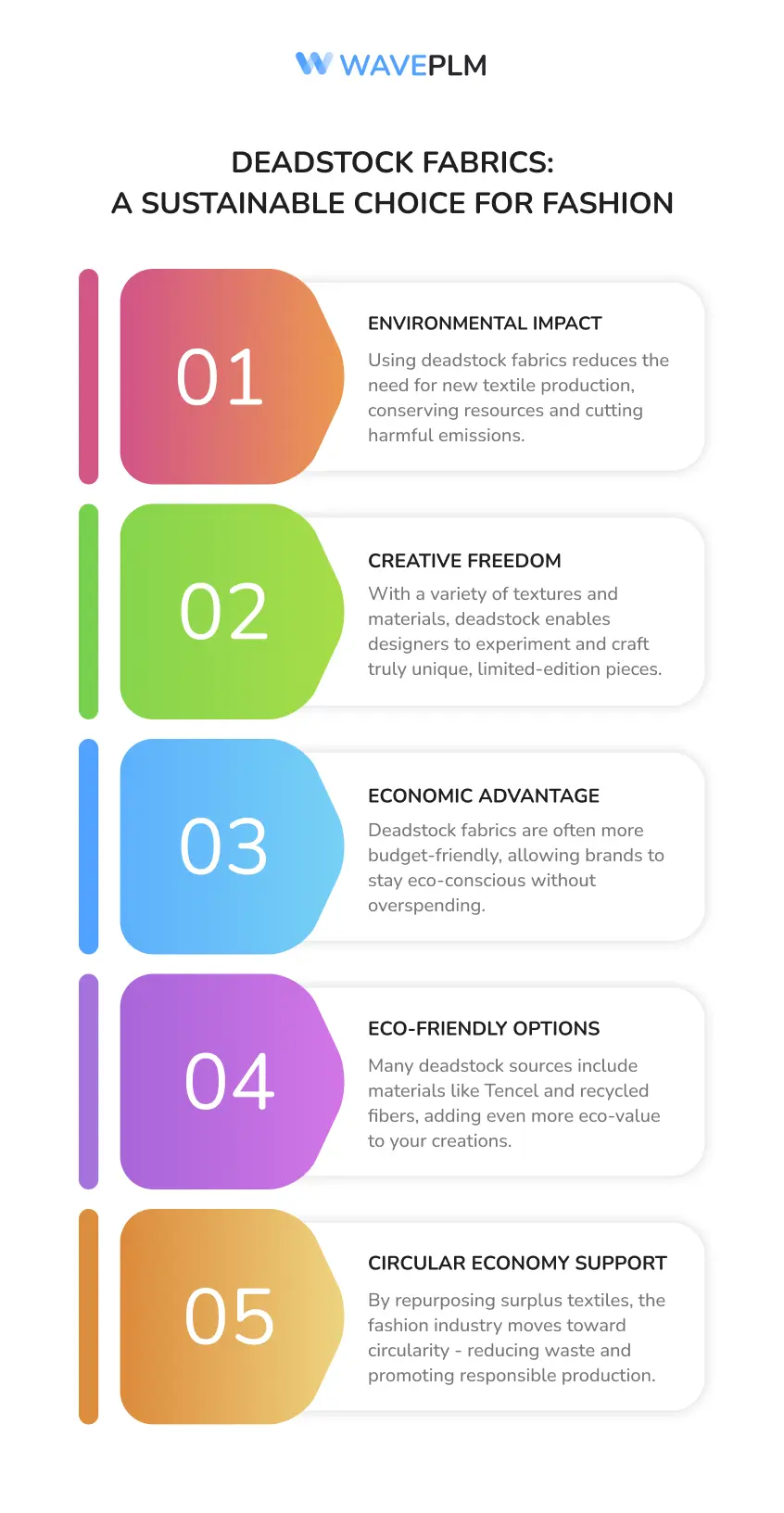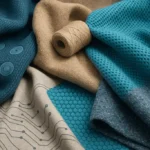
Deadstock fabric is surplus material from the fashion industry that would otherwise be discarded. It’s an eco-friendly choice for creating unique, sustainable projects. In this article, you’ll discover what deadstock fabric is, its benefits, how to source it, and inspiring project ideas.
Key Takeaways
- Deadstock fabric is surplus textile from the fashion industry, offering a sustainable way to create unique projects without new material production.
- Using deadstock fabrics helps reduce waste, showcases unique designs, and can be more economical, encouraging a circular economy in fashion.
- Sourcing deadstock involves looking for quality fabrics often found at fabric stockales or through jobbers, promoting transparency and fair pricing in the process.
What is Deadstock Fabric?
Deadstock fabric consists of surplus textiles from the fashion industry, often resulting from overproduction, end-of-season changes, or quality control rejects. Essentially, it’s the leftover material that clothing brands no longer need for their collections. Instead of letting these fabrics go to waste, they are given a second life through various creative projects.
One of the most compelling aspects of deadstock fabrics is that their production involves no new materials. All fabrics are sourced from surplus stock, meaning there is no additional strain on resources. This approach helps prevent landfill waste and promotes a more environmentally friendly crafting process.
Using deadstock fabric is a win-win situation: it helps reduce textile waste and allows you to create unique fashion pieces with rolls of fabric and a story behind every stitch. Who wouldn’t want to be part of such a meaningful chance movement?
The Benefits of Using Deadstock Fabrics

The environmental benefits of using deadstock fabrics are significant. Repurposing surplus materials mitigates the environmental impact of producing new textiles. This practice conserves resources and reduces emissions, making it a crucial step towards a more sustainable fashion industry.
In addition to being eco-friendly, deadstock fabrics offer a wide range of creative possibilities. These fabrics come in diverse textures and materials, allowing designers to experiment and innovate without limitations. Moreover, fashion items made from deadstock often have a unique character due to their limited availability, making each piece truly one-of-a-kind.
Economically, deadstock fabrics can be more affordable. They are often available at reduced prices, making it easier for brands to create eco-friendly collections without breaking the bank. Furthermore, some deadstock options include eco-friendly materials like Tencel and recycled fibers, adding another layer of sustainability to your projects.
Supporting the use of deadstock fabrics also encourages a circular economy. This approach promotes sustainable practices within the fashion industry, helping to reduce textile waste and foster a culture of environmental responsibility.

Sourcing Deadstock Fabrics
Finding deadstock fabrics can be an adventure in itself. These materials are often sourced from fabric mills that have overproduced or have leftover stock from previous seasons. Countries like Italy and France are renowned for producing high-quality deadstock fabrics, known for their unique prints and exceptional quality.
Jobbers play a crucial role in the deadstock market. These intermediaries buy deadstock fabrics in bulk and sell them to smaller retailers or fashion brands. If you’re looking to source deadstock for your next sewing project, it’s essential to verify the ownership and ensure there are no legal restrictions on resale. Transparency about the origins and condition of the fabrics helps build trust with customers.
Fair pricing is another important factor when sourcing deadstock. The prices should reflect the original cost and market value, maintaining ethical standards in the resale process. By prioritizing transparency and fairness, you can ensure that your sewing projects are both ethical and sustainable.
Popular Deadstock Fabrics for Sewing Projects

When it comes to sewing projects, certain types of deadstock fabrics are particularly popular:
- Natural fibers such as cotton, linen, and wool are commonly found in deadstock collections.
- These fabrics offer durability and comfort.
- They are perfect for creating timeless garments that can be worn season after season.
One of the joys of working with deadstock fabrics is discovering vibrant prints and patterns that aren’t available in mainstream options. Customers often mention they are thrilled by the unique textures and designs that add a special touch to their projects. However, it’s important to note that due to their limited availability, popular deadstock items can sell out quickly.
By incorporating these unique materials into your sewing projects, you not only create beautiful garments but also contribute to a more sustainable fashion industry with these products.
How to Shop for Deadstock Fabrics

Shopping for deadstock fabrics can be a delightful treasure hunt. Fabric stockales typically occur at least once a month, offering a variety of deadstock fabrics online. These sales provide an excellent opportunity to discover unique materials at affordable prices.
Joining online groups dedicated to deadstock fabrics can expose you to unique finds and affordable options. Some sellers even allow customers to make an appointment via Instagram to visit the fabric stockale in person. This personalized shopping experience ensures you get exactly what you need for your next sewing project.
Keep in mind that the minimum cut length sold at fabric stockales is usually 3 meters, which is ideal for most sewing projects. By following these tips, you can find high-quality deadstock fabrics that inspire creativity and sustainability.
Creating with Deadstock: Project Ideas
The possibilities are endless when it comes to creating with deadstock fabrics. Many sewers have found that using these materials has greatly inspired their projects, leading to innovative designs and techniques. The unique qualities of deadstock fabrics can elevate your skills and push the boundaries of your creativity.
Combining deadstock fabrics with core materials can help you create diverse collections. Whether you’re designing a statement dress or a cozy quilt, planning for the limited quantities of deadstock fabric is essential for maintaining design flexibility. This approach allows you to make the most of each piece of fabric while creating something truly special.
By embracing deadstock fabrics, you can understand how to create projects that accept not only beautiful but also environmentally conscious, as they are produced from sustainable deadstock fabrics that are close to nature and promote slow fashion with love in your next project.
Customer Stories: Success with Deadstock Fabrics
Customer stories highlight the success and satisfaction of using deadstock fabrics. Many have found that these materials not only reduce waste but also allow them to create unique, high-quality garments that stand out. The feedback often emphasizes the distinct prints and textures that add character to their projects.
Some customers have shared how using deadstock fabrics inspired them to adopt more sustainable practices in their sewing projects. Their stories illustrate a commitment to reducing textile waste and promoting a more sustainable fashion industry. These narratives serve as powerful testimonials, encouraging others to follow suit.
Sharing these experiences can inspire more people to feel explore the benefits of deadstock fabrics and contribute to a greener planet.
Supporting Sustainable Fashion Brands

Supporting brands that use deadstock fabrics is a crucial step towards a more sustainable fashion industry. These brands align themselves with ethical practices that appeal to environmentally conscious consumers. By reselling deadstock, they provide access to unique, high-quality materials at lower costs, promoting sustainability.
Buying from trusted deadstock suppliers ensures:
- High-quality fabrics that meet your expectations.
- Durability and aesthetics of deadstock materials, as highlighted in testimonials.
- Exceptional customer service from fabric stores specializing in deadstock to assist in making tailored fabric selections.
Supporting these brands allows you to promote sustainability and elegance in fashion, contributing to a positive ecological footprint.
Join the Community
Joining a community of sewing enthusiasts can elevate your experience with deadstock fabrics. FABCYCLE hosts a dedicated Facebook group where members can share inspiration, participate in sewing challenges, and receive updates on new fabric arrivals. This sense of community fosters connections and a shared passion for reducing textile waste.
Participating in these groups allows members to:
- Exchange experiences and tips on using deadstock fabrics effectively.
- Attend events hosted by online communities.
- Receive sneak peeks of new fabric arrivals, keeping members engaged and informed.
Joining these communities connects you with like-minded individuals committed to sustainable sewing, providing a supportive network that inspires creativity and environmental responsibility.
Summary
In summary, deadstock fabrics offer a wealth of benefits for sewing enthusiasts and the environment. From reducing textile waste to inspiring creativity, these materials are a fantastic choice for your next project. By sourcing and using deadstock fabrics, you contribute to a more sustainable fashion industry and create unique, high-quality garments.
So, why not give deadstock fabrics a try? Join the community, explore the possibilities, and make a positive impact on the planet, one project at a time.
Frequently Asked Questions
What are deadstock fabrics?
Deadstock fabrics are leftover textiles from the fashion industry, created by overproduction or rejected materials. They offer a sustainable option for those looking to reduce waste in fashion.
Why are deadstock fabrics considered sustainable?
Deadstock fabrics are sustainable because they keep unused materials from being wasted, cutting down on new production and helping conserve resources. It’s a smart choice for both the planet and your wardrobe!
How can I find deadstock fabrics for my sewing projects?
You can easily find deadstock fabrics by checking out fabric stockales, joining online groups, or reaching out to sellers on Instagram for appointments. Happy sewing!
What types of projects can I create with deadstock fabrics?
You can whip up all sorts of projects with deadstock fabrics, from stylish garments to cozy quilts and trendy accessories. They’re perfect for adding unique textures and patterns to your creations!
How can I join a community of sewing enthusiasts focused on deadstock fabrics?
Joining the FABCYCLE Sewing Group on Facebook is a great way to connect with fellow sewing enthusiasts who share your interest in deadstock fabrics. You’ll find inspiration, challenges, and updates that can keep your creative juices flowing!





Leave a Reply